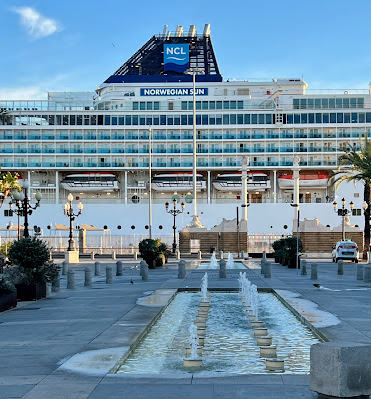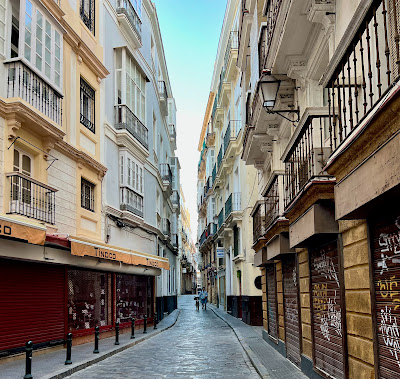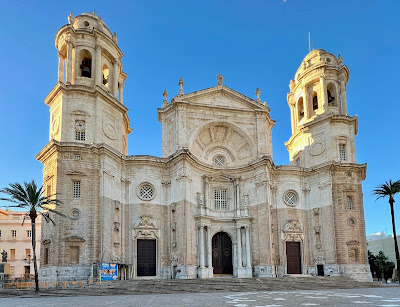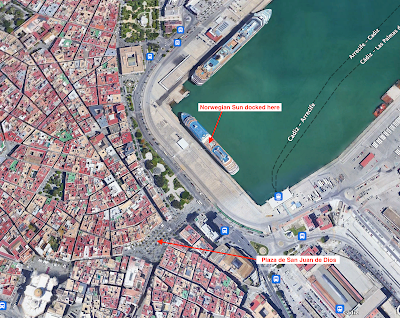Often regarded as the most ancient city continuously inhabited in Western Europe, Cadiz, Spain is famous for its well-preserved historical landmarks and watch towers. Situated right on the Andalusian Atlantic Coast, this port city brags of excellent beaches and a stunning Old Town where you can see Baroque and Neoclassical architecture all around.
Cadiz appears almost out of nowhere with only sea and empty coastline on both sides. Cruise ships dock right in the center of town making it easily accessible by foot.
 |
| 7am arrival into Cadiz. Main plaza in view |
The older part of Cádiz, within the remnants of the city walls, is commonly referred to as Old Town. It is characterized by the antiquity of its various barrios, among them El Pópulo, La Viña, and Santa María, which present a marked contrast to the newer areas of town. While the Old Town's street plan consists of narrow winding alleys connecting large plazas, newer areas of Cádiz typically have wide avenues and more modern buildings.
 |
| Street in Old Town |
 |
| View of Norwegian Sun from Main Square |
 |
| Main Square |
 |
| Narrow street of Old Town |
 |
| Architecture of Old Town |
In addition, the city is dotted with numerous parks where exotic plants flourish, including giant trees allegedly brought to Spain by Christopher Columbus from the New World.
 |
The Norwegian Sun docked in Cadiz, Spain at 7:00am on Sunday, November 20, 2022. The ship was cleared by 7:45am and I was standing on the main street of Cadiz at 8:00am.
Immediately across the busy main Avenida del Puerto, which parallels the port, is the main square of Plaza de San Juan de Dios with a tourist office, fountains, bars and shopping area.
Since most places don't open until 10am I decided to make my way to the bus stop "Plaza Espana". From our docking position you would turn right as you exit the port area and walk down Avenida del Puerto to the stop. The walk registered at 0.4 miles and will take about 8 minutes.
Those that follow my blog on a regular basis know I love to ride local buses and Cadiz is no exception. Cadiz has five urban lines with frequent service at very affordable prices. The cost for a single journey is 1.10 euros and can be purchased on the bus. You can also buy a 'Bonobus Pass' from tobacco stands and news kiosks for 7 euros for ten journeys. Changing buses is permitted within 45 minutes.
CADIZ URBAN BUS SCHEDULES/ROUTES
LINE 1
Starts at Plaza Espana
14 stops
Ending at Cortadura
LINE 2
Starts at Plaza Espana
23 Stops
Ending at Puntales/Barriada de Loreto
LINE 3
Starts at Plaza Espana
18 stops
Ending at Barriada de la Plaz/Puntales
LINE 5
Starting at Plaza Espana
17 stops
Ending at La Barriada de Loreto/Zona Franca
LINE 7
Starting at Ingeniero de la Cierva
11 stops
Ending at Glorieta Simon Bolivar
I boarded the first bus that stopped, line #2 Plaza Espana-Barriada de Loreto, and was off for my adventure. Staying on for the entire loop I finally found myself back in Old Town just as the city was coming to life.
The Cadiz Cathedral, is a Roman Catholic Church built between 1722 and 1838 and a must on my list.
During its long construction period of 116 years, the Cathedral underwent several major changes to its original design. It was originally intended to be a Baroque edifice. It was finally completed in the Neoclassical style but also contains Rococo elements. The Plaza de la Cathedral houses both the Cathedral and the Baroque Santiago Church, built in 1635.
 |
| Cadiz Cathedral |
The Cathedral is open for visitors and offers audio guides in different languages. If you are feeling energetic you can climb the 141 ft high Levante Tower, one of the last elements to be built in the 19th century, and enjoy panoramic views of the city.
 |
| Cadiz Cathedral Tower |
The famous Spanish composer and pianist Manuel de Falla is buried in the crypt.
 |
| Inside Cadiz Cathedral |
 |
| Inside Cadiz Cathedral |
La Caleta is a beach located in the historical part of the city. It is a natural harbor penetrated through history by Phoenicians, Carthaginians and Romans. It is also the smallest beach in the city and is isolated from the others.
 |
| Entrance to La Caleta Beach and Castillo de Santa Catalina |
It runs between the Castles of San Sebastián and Santa Catalina. It has also been pictured in several films, such as 007: Die Another Day, Alatriste and Manolete.
These 2 castles stand on either side of La Caleta beach. The Castillo de Santa Catalina, entered directly from the promenade, was constructed in the 17th century. Its small chapel and a central patio planted with palms give it the sun-baked look of a Mexican mission. The Castillo is now a cultural center where open-air concerts are held in summer.
The Castillo de San Sebastian, meanwhile, is an imposing fort from 1706 built on a small island connected to the mainland by a long stone causeway. This "malecon' is popular among locals and visitors as a pleasant place to walk for a cool breeze.
 |
| Starting the walk out to Castillo de San Sebastian |
 |
| Getting close to the main gate of Castillo de San Sebastian |
 |
| Selfie at entrance to Castillo de San Sebastian |
Time passed quickly so it was back to the ship for a 4pm sailing. My iPhone "Steps" app indicated I had walked a total of 12,037 steps for 5.3 miles. Tomorrow I disembark in Lisbon, Portugal ending my 21 day TransAtlantic crossing.













No comments:
Post a Comment